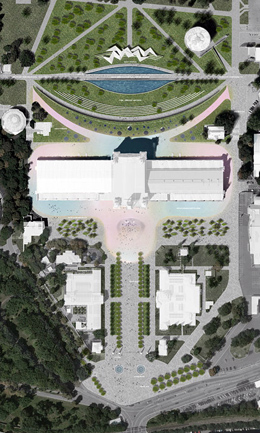
The Industrial Palace with a 120-year tradition is awaiting a new face
Source
Iva Pokorná
Iva Pokorná
Publisher
ČTK
13.03.2011 17:00
ČTK
13.03.2011 17:00
Czech Republic
Prague
Cigler Marani Architects, s.r.o.
 |
However, aside from organized events, the palace has always been and is essentially a "dead" object. The long-neglected monument was also damaged on October 16, 2008, by a massive fire that ravaged the entire western (left) wing, causing the building to lose its monumental symmetry. Immediately after the fire, the then Prague mayor Pavel Bém stated he would advocate for the palace to be rebuilt. Nevertheless, it took less than two years for Prague to announce an architectural competition for its reconstruction. Only last June did the city council agree that the palace would be rebuilt according to the design by architect Jakub Cigler and his studio Cigler Marani Architects a.s. The palace could be completed in about two years. The builders of the Jubilee Exhibition constructed the building in just under nine months, and the construction, which commenced on June 30, 1890, was delayed in September by flooding (which submerged two-thirds of the exhibition area) and the collapse of part of the structure.
The Industrial Palace, built in the historical style (often mistakenly referred to as Art Nouveau), is the work of architects Bedřich Münzberger, who was also the author of the Palacký Bridge, and František Prášil, the designer of the Petřín Lookout Tower. The exhibition committee rejected Münzberger's first design for a brick building. However, the new design for the iron palace "surprised everyone with its lightness and elegance in composition."
This resulted in the first prefabricated steel structure combined with glass in the Czech lands. To ensure that the metal structure did not appear merely "utilitarian," the palace was given a representative elegance thanks to brick facades and four pylon towers at the corners of the central part. The exterior decoration of the brick architecture with its historicizing decor was designed in 1891 by Bedřich Ohmann, with additions made by Alois Dryák in 1899. The façade was originally decorated with a portal featuring statues of Czech giants (the rear portal has been preserved), and the wings housed busts of significant Czech engineers. The interior decoration was the work of architect Josef Fanta, with contributions from Mikoláš Aleš.
The central part of the palace, which was untouched by the fire, is monumental. The hall measures 65 by 45 meters, with steel arches soaring 25 meters high and spanning 38 meters. There is a gallery with loggias along the perimeter, accessible via staircases in the corner towers. Light enters the interior through enormous areas of cathedral-style glazed walls. The view of the coffered, decorated ceiling is also impressive.
The silhouette of the palace is completed by the central iron tower, which rises 51 meters high. Four airy corner pillars extend into a roof dome with a clock, and there is a spiral staircase leading up into the open space in the middle. Due to its valued authentic steel structure, the Industrial Palace is listed as a cultural monument as part of the Exhibition Grounds, which has been monumentally protected since the 1950s.
The former regime not only gave the palace the nickname "Congress," but it also renovated it for its new purpose (from 1952 to 1954). According to the design by architect Pavel Smetana, the entrance portal was stripped of decorations, and new arches were added. The royal crown on the tower was replaced by a red star. The era of mass gatherings began in February 1948 with the Congress of Factory Councils. As part of the Park of Culture and Leisure of Julius Fučík, it continued to host large exhibitions, concerts, and other events.
The centennial tradition was recalled, albeit with modest success, by the Czechoslovak General Exhibition in 1991, featuring the restored Krížik Fountain.
After the unfortunate fire caused by an electric cooker, the Industrial Palace and the Exhibition Grounds face a new future. The burnt wing will be replaced by a replica built in the old-fashioned method of riveted construction. The entire palace is to be cleared of the "deposits" that accumulated after 1891. An original underpass will then connect the entrance area with the Krížik Fountain, and the technical background or parking spaces will be hidden underground in the palace. The project also involves the reconstruction of the Krížik Fountain and its surroundings and the connection of the Exhibition Grounds with Stromovka.
The English translation is powered by AI tool. Switch to Czech to view the original text source.
Related articles
0
03.04.2017 | Prague has selected a contractor for the project of completing the Industrial Palace
0
15.02.2017 | Prague could decide on the completion of the Industrial Palace this year.
4
02.11.2016 | Instead of the burned wing of the Industrial Palace, there will be a temporary hall
0
28.03.2015 | The project for the completion of the Industrial Palace will cost Prague 40 million
0
17.01.2015 | The reconstruction of the burnt Industrial Palace will begin in two years
0
03.09.2014 | Prague is looking for an architect to design the extension of the Industrial Palace
0
03.05.2011 | Prague will sign a contract for the project of completing the Industrial Palace
20
01.06.2010 | The Industrial Palace will be completed according to the design of Jakub Cigler
1
09.03.2010 | Prague has announced an architectural competition for the Industrial Palace
22
12.01.2010 | Vojtěch Hybler - bachelor's project for the completion of the Industrial Palace in Prague
0
13.02.2009 | The fire in the Industrial Palace was caused by an electric cooker
0
25.11.2008 | The magistrate received the documentation for the Industrial Palace as a gift
0
21.10.2008 | The destroyed Industrial Palace is to be restored by 2010 after the fire
13
17.10.2008 | Experts: The palace can be rebuilt, but it will no longer be authentic











